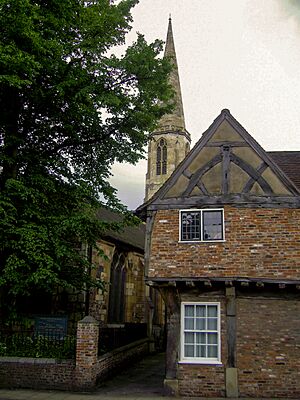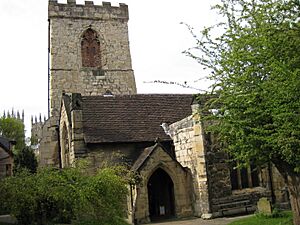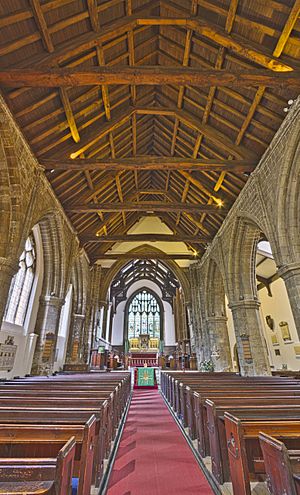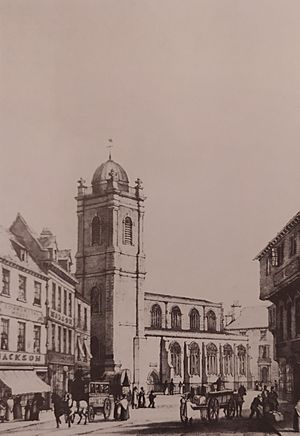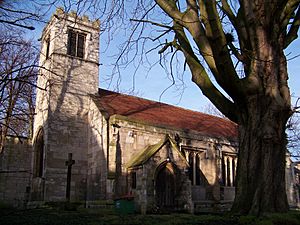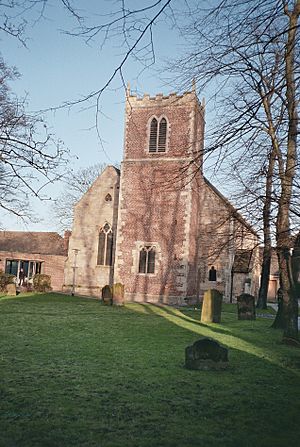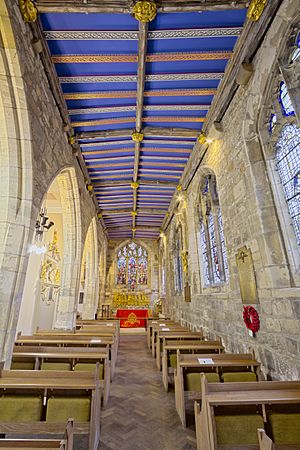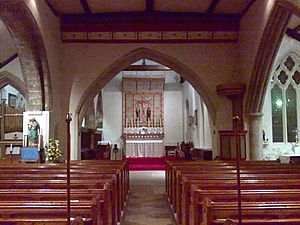Medieval parish churches of York facts for kids
York was once home to many churches, with about 45 parish churches in the year 1300. Today, 20 of these old churches still stand, either fully or partly. This number is only beaten by Norwich in England! Twelve of these churches are still used for worship today.
In 1086, a famous survey called the Domesday Book listed eight churches and a large church called a minster in York. By 1428, the number of churches had dropped to 39 because of taxes. This article will tell you about the medieval churches that still exist in York. It will also mention some that have completely disappeared.
Contents
- Amazing Medieval Churches Still Standing in York
- All Saints, North Street: A Church with Ancient Windows
- All Saints, Pavement: A Guiding Light for Travelers
- Holy Trinity, Goodramgate: A Glimpse into the Past
- Holy Trinity, Micklegate: A Priory's Remains
- St Crux, Pavement: The Lost Giant
- St Cuthbert, Peasholme Green: The Cradle of Canada
- St Denys, Walmgate: A Church with Roman Roots
- St Helen, Stonegate: A Church in a Square
- St John, Micklegate: From Church to Bar
- St Lawrence, Lawrence Street: A Tower from the Past
- St Margaret, Walmgate: A Porch with Zodiac Signs
- St Martin Coney Street: A Church Reborn from Bombs
- St Martin-cum-Gregory, Micklegate: A Stained Glass Hub
- St Mary Bishophill Junior: York's Oldest Survivor
- St Mary, Castlegate: An Art Space
- St Michael, Spurriergate: A Café and Counselling Centre
- St Michael-le-Belfrey, High Petergate: A Rebuilt Church
- St Olave's, Marygate: Dedicated to a Viking Saint
- St Sampson, Church Street: A Centre for Seniors
- St Saviour, St Saviourgate: An Archaeological Adventure
- Medieval Churches That Are No Longer Standing
- All Saints, Fishergate: A Lost Abbey Church
- All Saints (in the Marsh), Peasholme Green: Digging Up the Past
- Holy Trinity (also known as Christ Church), King's Square: A Sheep's Home
- St Crux, Pavement: A Reminder of What Was
- St Mary, Bishophill Senior: Stones Reused
- St Maurice, Monkgate: Replaced and Gone
- St Nicholas, Lawrence Street: Damaged in War
- Images for kids
- See also
Amazing Medieval Churches Still Standing in York
These churches are very old and still exist today, showing us what life was like long ago.
All Saints, North Street: A Church with Ancient Windows
All Saints was first built in the 1000s. However, most of what you see today was built in the 1300s and 1400s. It's said that the land for the church was given by a Norman lord named Ralph de Paganel.
This church is in a beautiful spot near the River Ouse. It's also next to some cool 15th-century timber-framed houses. The most striking part of the outside is its tall tower with an octagonal spire. Inside, you can see amazing 15th-century wooden roofs and lots of old stained glass. Some windows show the "Corporal Works of Mercy" and the "Prick of Conscience" windows. The "Prick of Conscience" windows show 15 signs that people believed would happen at the End of the World.
All Saints, Pavement: A Guiding Light for Travelers
A church has stood on the site of All Saints since before the Norman Conquest in 1066. The church you see now was mostly built in the 1300s and 1400s. Like another church, St. Denys, part of this building was taken down in the late 1700s. This was done to make the market area in Pavement bigger.
The most famous part of the church's outside is its octagonal lantern-tower from around 1400. For many years, a light in this tower helped guide travelers at night. Inside, there's a unique hexagonal pulpit from 1634. You can also see beautiful 15th-century stained glass in the west window. It shows scenes from the life of Christ and might even reflect the old Miracle Plays that were performed.
Holy Trinity, Goodramgate: A Glimpse into the Past
Holy Trinity was started in the early 1100s. Most of its current look comes from the 1200s and 1300s. The wooden parts and pews inside are from the 1600s and 1700s. This church is a great example of how churches looked after the Reformation.
The churchyard is hidden away behind old buildings, reached by narrow paths. Stepping inside feels like going back in time to the late 1600s. It's dark, quiet, and cozy, with uneven floors and tall box pews. The most special part of the church is its medieval stained glass. The best is the east window from 1470-1471. It was given by the rector, John Walker. The glass shows saints like St George and St Christopher.
This church is now looked after by the Churches Conservation Trust.
Holy Trinity, Micklegate: A Priory's Remains
The main part and tower of Holy Trinity, Micklegate are what's left of an old Benedictine priory church. This priory was built on the site of an even older church from before the Norman Conquest. The current main part of the church was built in the late 1100s and early 1200s. The tower was built after 1453.
After the priory was closed in 1538, the church started to fall apart. It was greatly repaired from the 1850s onwards. Today, the church has an exhibition for visitors. It teaches about the monastic life of the priory.
St Crux, Pavement: The Lost Giant
St Crux, which means Holy Cross, was the biggest medieval parish church in York after it was rebuilt in 1424. A brick tower was added in 1697. The church closed around 1880 because it became unsafe. Sadly, not enough money was raised to rebuild it, so it was torn down in 1887.
However, some of the church's stone was used to build the St Crux Parish Hall. This hall is at the bottom of the Shambles. The hall still has some monuments from the old church. Other parts are now in All Saints, Pavement. You can still see part of the 15th-century stone wall of St Crux. It's now part of a building at 23 The Shambles and a narrow path called a Snickelway. The hall is currently used as a café.
St Cuthbert, Peasholme Green: The Cradle of Canada
St Cuthbert's Church was built near the York city walls at Layerthorpe Postern. Rectors, or church leaders, have been here since 1239. The building you see today dates back to 1430. It was largely rebuilt by William de Bowes, who was the Lord Mayor of York twice.
The Bowes family lived nearby in what is now the Black Swan Inn. Later, the Thompson family lived there. One of their daughters was the mother of James Wolfe, a famous hero from Quebec, Canada. Because of this connection, the church is sometimes called "The Cradle of Canada." You can see the flags of Canada and the US in the church to remember this link.
St Denys, Walmgate: A Church with Roman Roots
St Denys's Church, York stands in a churchyard that is higher than the surrounding roads. It is named after St Denys, who is the patron saint of France. There is proof that this spot was used by buildings from the Roman and Viking or Anglo-Saxon times.
The church you see today is the chancel (the area around the altar) of the original medieval building. It's only about one-third of the size of the original church. The west end was taken down in 1797. The central tower was damaged during the Siege of York in 1644 and later struck by lightning. The current tower was built in 1847.
St Helen, Stonegate: A Church in a Square
St Helen's Church, Stonegate, York faces St Helen's Square, which used to be the churchyard. The oldest part of the church is a font from the mid-to-late 1100s. Like other medieval churches in York, it was probably founded before the Norman Conquest.
Even though it was rebuilt twice, in the 1550s and 1857-58, the church is still mostly medieval. The tower (from about 1814) and the chancel (from 1858) are the main newer parts. The west window has a lot of beautiful 14th and 15th-century glass.
St John, Micklegate: From Church to Bar
St John's Micklegate is a simple rectangular building. The oldest parts, including the base of the tower, are from the 1100s. Most of the current building is from the 1400s. The church closed in 1934.
It later became an Institute of Architecture and then an Arts Centre for the University of York. Now, it's a bar! A fun fact is that the ropes for the church bells hang around the bar area. Sometimes, the bells are still rung, but not very often.
St Lawrence, Lawrence Street: A Tower from the Past
The main St Lawrence building you see today is Victorian. However, in its churchyard, there's a small tower from the older church. This tower dates back to the 1100s, with its top part added in the 1400s.
The tower, which is cared for by the Churches Conservation Trust, has an impressive Norman doorway. This doorway used to be one of the entrances to the main part of the old church. The area where the old church stood is now marked by medieval and 18th-19th century gravestones. The old medieval font and some other old furnishings can still be seen in the 'new' church.
St Margaret, Walmgate: A Porch with Zodiac Signs
St Margaret is one of only two medieval churches left in the Walmgate area. It dates back to at least the 1100s, but most of the building is from the 1300s. The main exceptions are the red brick tower, built in 1684, and the Romanesque south porch.
This porch is special because it's decorated with carvings of the signs of the zodiac and the "labours of the Months". The porch originally belonged to another church, St Nicholas's Hospital, which was ruined during the English Civil War. It was moved to St Margaret's around the same time the tower was rebuilt.
St Margaret's was repaired and made bigger in 1850-51. However, fewer people attended, and it was declared no longer needed for worship in 1974. It was then used as a storage space. Since 2000, it has been used as a performance space and conference center by the National Centre for Early Music.
St Martin Coney Street: A Church Reborn from Bombs
Often called St Martin le Grand, this church has parts dating back to about 1080. The church was mostly destroyed in a bombing raid on April 29, 1942. However, the 15th-century tower and south aisle survived.
A special window, the St Martin window from about 1437, was moved before the raid for safety. It is now the largest medieval window in York outside the Minster. The church is famous for its restoration, finished in 1968. It successfully mixes the old 15th-century parts with new, modern elements.
The church is also known for its large clock that hangs over the street. It has a figure of a naval officer on top, dating from 1778.
St Martin-cum-Gregory, Micklegate: A Stained Glass Hub
Part of the main section of St Martin-cum-Gregory is from the 1200s. The rest of the building dates from the 1300s and 1400s. This church is now being developed as a center for stained glass. It also hosts art events sometimes.
St Mary Bishophill Junior: York's Oldest Survivor
Many people agree that St Mary Bishophill Junior is the oldest church still standing within York's city walls. The church is in an area that was once the Roman part of Eboracum (the Roman name for York). You can even see pieces of Roman tile in the tower!
The tower itself is from the late Anglo-Saxon period. It's built with different materials, including brown sandstone and limestone blocks. Some stones are laid in a "herringbone" pattern. A typical Anglo-Saxon feature is the double-arched belfry windows. Inside, the church has what is called "the finest pre-Conquest tower arch." There are also pieces of stone from before the Norman Conquest inside.
St Mary, Castlegate: An Art Space
St Mary's Castlegate is now used as an art space. It has different exhibitions organized by the York Museums Trust.
St Michael, Spurriergate: A Café and Counselling Centre
St Michael's, Spurriergate is run by a trust and is used as a café called The Spurriergate Centre. It's also a Christian Counselling centre. It has some important stained glass and still has a set of six bells that are rung sometimes.
St Michael-le-Belfrey, High Petergate: A Rebuilt Church
St Michael-le-Belfrey is mentioned here, but it's not strictly a medieval church. The original church was completely torn down and rebuilt between 1525 and 1536. The only part left from the old church is the 14th-century stained glass in the east window.
St Olave's, Marygate: Dedicated to a Viking Saint
St Olave's (pronounced Olive) is located within the walls of St Mary's Abbey. The abbey was ruined when monasteries were closed. This church is dedicated to Olaf, who is the patron saint of Norway. It's thought that the church was founded by Earl Siward of Northumbria before the Norman Conquest. The medieval church was repaired in the 1700s. A new chancel was added in 1887-89. This part holds the 15th-century east window.
St Sampson, Church Street: A Centre for Seniors
St Sampson's Church, on Church Street, has been changed and is now used as a 'drop-in centre' for people over 60.
St Saviour, St Saviourgate: An Archaeological Adventure
St Saviour's Church, York is now used as a learning centre by the York Archaeological Trust. It's called DIG: an archaeological adventure. You can visit it alone or with groups like schools. It also has changing exhibitions.
Medieval Churches That Are No Longer Standing
Many medieval churches in York have been completely demolished over time. Here are some of them.
All Saints, Fishergate: A Lost Abbey Church
This church was built in or before the 1000s. It was given to Whitby Abbey around 1095. After the dissolution of the monasteries (when many religious buildings were closed), it quickly fell out of use. By 1549, it had completely disappeared.
All Saints (in the Marsh), Peasholme Green: Digging Up the Past
This church was no longer used and partly torn down in 1586. Some parts could still be seen on a map of York from 1610. It was next to the Black Swan inn, which still exists. The York Archaeological Trust has been digging at this church site. They found many graves of children and adults, covering about 400 years of history.
Holy Trinity (also known as Christ Church), King's Square: A Sheep's Home
This church was largely rebuilt in the 1800s. It closed in 1886 and was no longer used. By 1896, it was even housing a small group of sheep! It was torn down in 1937. However, some gravestones from its churchyard can be seen in King's Square. A large stone in the square also remembers the church.
St Crux, Pavement: A Reminder of What Was
Although the main church was demolished, some of its stonework was used to build the St Crux Parish Hall. This hall contains monuments from the old church. Part of the 15th-century north aisle wall still stands as part of a building on The Shambles.
St Mary, Bishophill Senior: Stones Reused
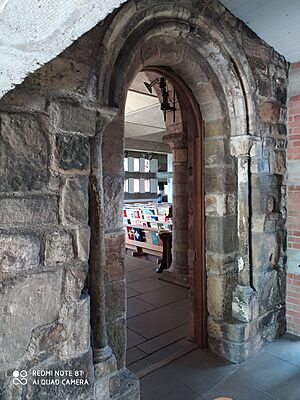
The medieval church of St Mary, Bishophill Senior, used stones from Roman and Northumbrian times. It was repaired in 1866 but was in ruins by the mid-1900s. Even though it was a very important historical building, it was torn down in 1963.
When it was demolished, some monuments and fittings were moved to another church. Parts of the building were even reused in the Holy Redeemer Church. The churchyard still remains, with many memorials and a 19th-century wall and gates. This wall includes part of a 10th-century building.
St Maurice, Monkgate: Replaced and Gone
This church was torn down in 1876 and replaced by a new church. That new church was also torn down in 1966. Some of its graveyard can still be seen on the corner of Lord Mayor's Walk.
St Nicholas, Lawrence Street: Damaged in War
This church was part of the 12th-century St Nicholas's Hospital. It was badly damaged during the Siege of York in 1644 by cannon fire. The steeple and south wall were still standing in 1730, but other parts were reused or stolen. Its beautiful Norman doorway was moved to St Margaret, Walmgate. The area where it stood is now a nature reserve called St Nicholas Fields. It has a modern stone circle that uses some stones from the church.
Images for kids
See also
 In Spanish: Iglesias medievales de York para niños
In Spanish: Iglesias medievales de York para niños


